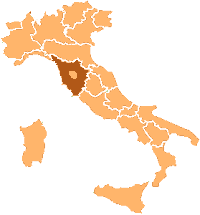The history of Chianti goes back a long way. The world famous wine takes its name from the Chianti region in central Italy. It’s based on the Sangiovese grape in percentages which go from 80% to 100%. It can contain other varietals usually Cabernet or Merlot up to 20%. Chianti is dry, high in acidity, with an alcohol content of about 13.5%. The aromas and flavors tend to be fruity of cherries when young, and of ripe plums and spices when aged. Read this article for your enjoyment, and if you'd care to for a
Tuscany wine tour, you can find me here.
 |
| The New Logo for Chianti Classico |
Chianti wines have a number of denominations depending on the area where they are produced, but the only two to consider (in my opinion) if you want a high quality wine are “Chianti Classico” and “Rufina.” Chianti Classico is the wine made in the original historic wine making zone which was legally defined in 1716. As Chianti became more popular but centuries later, in 1930, the original geographical boundaries of the Chianti wine region were extended, and a further seven sub zones (denominations) were added. They are: Colli Aretini, Colli Fiorentini, Colli Senesi, Colline Pisane, Montalbano, Montespertoli, Rufina.
In the 1600’s, wine coming from a well defined zone, made from 100% Sangiovese grapes and called Chianti was being exported to England, so it’s been around with some form of regulation for a long time. In the 1840s, Baron Ricasoli, owner of Brolio Castle and the Brolio estate, did many experiments in wine making. He came to the conclusion that blending the autochthonous Sangiovese grape with 30% white varieties would produce a better wine and deposited his findings. However the Italian government ratified Ricasoli's formula into law only in 1966.
Unfortunately bad farming practices only concerned with quantity, and the addition of low quality white grapes resulted in low quality wine. As you may well know, it was bottled in a fiasco, the straw-covered bottle and “candle holder” which epitomized cheap Italian wine in the late 1960s. The reputation of Chianti sank to an all time low, and sometimes it’s still thought of this way.
In the 1970s, a small number of wineries in Chianti, and other areas of Tuscany adopted different wine making philosophies. They foresightedly focused on quality rather than quantity, and stopped following the production rules of the time. They included Cabernet Sauvignon and Merlot in their wines, and excluded poor quality white grapes from their blends. They also introduced ageing in small 225 litre barrels. The aim was to produce wines in the style of the top French wines for a more international appeal. Some felt (and still do) that by blending "international" grapes with Sangiovese, the tradition of Chianti was being lost, and they chose to bottle 100% Sangiovese wines, however for the rules of the time, this too was not permitted, because Chianti had to include white grapes.
Not following the rules, the new wines lost the right to be called Chianti, and they had to be marketed as table wines, which is the lowest definition of quality in Italy. However once the American press got hold of them, and realizing the undeniable quality, they were dubbed "Super Tuscans" as no other official term was available, and the name stuck. Today the Italian government has coined an officila denomination for Super Tuscans, and they go under the general name of IGT’s, which is an acronym for “Typical wine from defined geographical area.” As often happens with Italian rules, IGT means everything and nothing, wines of great quality, or junk.
You’ll have to take a trip with me to find the good ones, and fortunately they do exist.
On the wake of the success of the Super Tuscans, the regulations of Chianti have been changed to accommodate the new vinification techniques. White grapes are no longer allowed and they have been substituted with international grapes such as Cabernet and Merlot (up to 20%), and infinite care is taken in the vineyard and cellar. Today Chianti is one of the world’s better wines and has little to do with the past.
As mentioned earlier I feel the best comes from Chianti Classico and the Rufina areas. Unfortunately they are also the most expensive. If you want to spend less, try the wines from the other sub zones which considering the price, won’t disappoint. if you'd like to learn more on the
History of Chianti, click here:
Sergio Ceccherini





